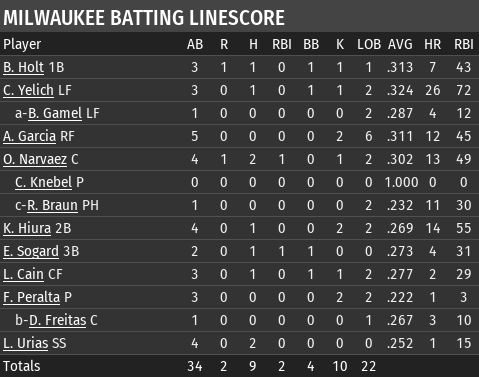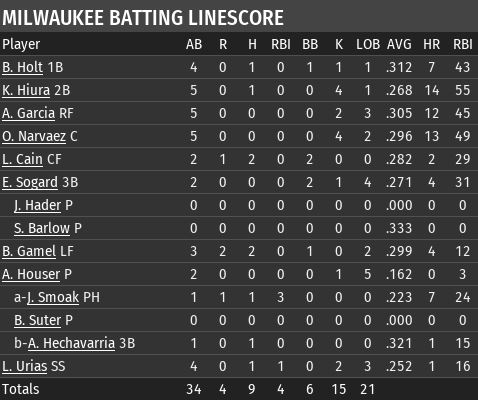Predicting breakout candidates is one of the hardest and most frustrating tasks for anyone who tries their hand at baseball soothsaying. By its very nature, a breakout (or breakdown) projection is a low probability event. If it wasn’t, it would be the basic projection! Your big hits will be next to some embarrassing mistakes. For example, if I were of a mind to gloat about having said in this 2018 piece for ESPN that Christian Yelich had a peak Joey Votto/Will Clark season in him, I couldn’t get around the fact that the player listed right after Yelich was Danny Salazar, who has appeared in one game since that article ran.
So what constitutes a breakout season? Is it a player making a significant change in one aspect of their game? A bounce-back season? Is a top prospect showing improvement a breakout? Or is it a sudden step forward along broad lines? I’d argue that it’s any and all of these things. I used to try to statistically define a breakout season, but in the end, I found no purely mathematical estimation that was satisfactory. As I’ve written this piece over the years, I’ve gone with a more abstract definition: when a player, capable of contributing to a playoff contender, is able to fundamentally change what we think of them.
Predicting breakouts and breakdowns for 2020 is even tougher than usual thanks to the 60-game season, which will complicate knowing if I’m right even if it is somehow miraculously played to completion. But it’s part of the job, so let’s get to the bet-making instead of the bet-hedging. Here are my 10 favorite breakout picks for 2020.
Eloy Jiménez, Chicago White Sox
Eloy Jiménez had a vaguely disappointing rookie year in 2020, with a .513 slugging percentage in a pinball season not enough to balance out the .315 on-base percentage and mediocre defense. What keeps me a believer is that he was a more well-rounded hitter in the minors than he’s displayed in the majors and it’s way too soon to peg him as a low-OBP slugger. It was encouraging that his plate discipline numbers improved over the course of 2019, and ZiPS thinks his second-half .337 BABIP is closer to his real number than his .275 over the season’s early months.
I don’t think a year similar to Yordan Alvarez’s .313/.412/.655 2019 would be all that shocking. Neither does ZiPS; in a 600 PA season, it put his 90th percentile home run total at 54.
I kind of wanted to put Nomar Mazara here as a tandem, but I resolved to stop picking him after doing so for three consecutive seasons and whiffing each time. A breakout is still a possibility for Mazara, but if I pick him for a decade and he finally does break out, I’d just be the blind squirrel finding the nut.
Adrian Houser, Milwaukee Brewers
You’d be excused for not getting excited about Adrian Houser as a prospect; he was never especially enthralling in the minors. What was exciting, however, was Houser’s two-seamer/sinker, which he used to great effect in 2019. Pitch-classification algorithms can have issues with a pitcher like Houser, but while he upped his grounder game considerably last season — useful for a right-handed pitcher given Miller Park’s history as a haven for left-handed sluggers — he did it while avoiding the somewhat dated approach of simply constantly throwing hard and down.

Houser did have considerable splits last year depending on his role, with a 4.57 ERA as a starter compared to 1.47 in relief. But in a rotation that seems overstuffed with third and fourth starters, Houser’s upside is interesting.
Dinelson Lamet, San Diego Padres
One thing people forget about Dinelson Lamet is how little experience he actually has as a pitcher, with only 500 professional innings under his belt. I think there’s a good chance that if not for the Tommy John surgery, he’d be a legitimate ace right now for the Padres; his change was a work in progress at the time. Lamet has been 16 runs below-average with his mid-to-upper 90s fastball — which came back faster post-surgery — but I don’t think this is a case of Nathan Eovaldi, a pitcher who had trouble turning his velocity into outs. Lamet just hasn’t the time to refine his potent fastball-slider combination yet.
Luis Urías, Milwaukee Brewers
It strikes me as odd that in some circles Luis Urías is already thought a bust despite just turning 23. After sitting out the spring with a recovering from surgery on a broken hamate bone, Urías’ poor injury luck has continued; he tested positive for COVID-19 prior to the Brewers’ intake procedure for training camp. His case was reported to be asymptomatic and while we have little practical evidence of how cases like that will affect elite athletes, Craig Counsell appeared optimistic about Urías’ chances of rejoining the team in fairly short order. Urías had a disappointing stint in the majors in 2019, but even taking a huge chunk out of his .315/.398/.600 Triple-A effort due to the league offense and the level, there’s strong evidence that his baseline is well above his .223/.329/.326 major league line last year.
Victor Robles, Washington Nationals
It seems a little weird with the benefit of hindsight, but Victor Robles was always supposed to be the new hotness before Juan Soto exploded onto the roster in 2018. Robles isn’t going to catch up to Soto any time soon — or likely ever — but he showed signs of being a fairly complete hitter as a prospect and his defense in center field has been about as good as advertised. His main problem remains that he makes very soft contact, especially on groundballs, and I think his tendency to be overaggressive on the first pitch and top a soft grounder is hurting him here; he just doesn’t have the contact skills of a David Fletcher. Victor Robles will never hit for power like a Joey Gallo, but better pitch selection would give him a shot at retaining his 2019 home run bump. Too much of his current plate discipline comes from simply being willing to take a hit by a pitch.
Dansby Swanson, Atlanta Braves
Poor Dansby Swanson is at risk of becoming the new Gregg Jefferies, a player who is always measured versus our lofty initial expectations, found wanting, and ends up underrated by “only” being a B+ player in the majors. Swanson hit the ball harder in 2020 than he ever had before in the majors, with his barrel rate more than doubling his 2017 and ’18 numbers and his weak contact hits dropping considerably. It didn’t show up in his overall stats, but ZiPS “thought” he should actually have been a .492 slugger instead of the .422 mark he posted. zSLG isn’t an outlier, either; Statcast’s xSLG had Swanson at .480.
Dylan Bundy, Los Angeles Angels
My working theory on Dylan Bundy is that he needed a change of scenery more than practically any pitcher in the majors, both figuratively in terms of coaching and literally in terms of a park better configured to contain his mistakes. Bundy came out of high school nearly a decade ago as a hard thrower, a pitcher who regularly hit the high-90s and was clocked at 100 as an amateur. Years of injuries killed off the fastball, but Bundy continued to pitch as if he was still that pitcher, aggressively challenging hitters with a 91-92 mph four-seamer. That doesn’t actually work against major league hitters; for his career, he’s allowed a .542 SLG on four-seamers, including a .574 in 2018 and a .642 in 2019.
Bundy has to reinvent himself the way Frank Tanana did after his injury. There were signs of progress at times in 2019, with Bundy trying to change speeds more often. I still think there’s upside here if the Angels convince Bundy that his comps fall along the lines of Doug Fister, not Randy Johnson.
Byron Buxton, Minnesota Twins
Byron Buxton thrived last season when the Twins finally did what they’d resisted doing for years: sticking him in the lineup, letting him play, and not panicking every time he had a bad week. ZiPS gives Buxton a 10% chance at a 130 OPS+, enough that it would make him a superstar when combined with his defense. The shoulder is a concern, but he’s also had the luxury of more time to recover because of the pandemic’s long layoff.
Mitch Keller, Pittsburgh Pirates
I can’t think of a scenario in which Mitch Keller’s .475 BABIP in 2019 represents an actual ability. I’m not convinced that Mitch Webster, coming out of retirement and converted to pitching, would allow a .475 BABIP. Historically, hitters being dragooned as pitchers have a BABIP allowed in the .330 range, which I think sets a soft ceiling of minimal pitching competence. But it was such a wacky number that even ZiPS is having trouble coping and I’d take the under on the .328 projection, even with Keller having similar issues in the minors, though not to the same extreme. Like Lamet above and my eternal example, Kevin Gausman, I think Keller really needs an offspeed pitch he can count on, but the talent is there. It’s hard to strike out 12 batters a game and have no idea what you’re doing.
Tyler Anderson, San Francisco Giants
There’s a chance that this is personal bias since his windup always gives me nightmares in MLB: The Show, but Tyler Anderson was always on the verge of breaking out as command-type pitcher in Coors and with a better outfield defense and a friendly park in San Francisco, I think he could have a Kirk Rueter-type run of success. And yes, I know he’s more of a strikeout pitcher than Rueter — the comp isn’t perfect. Having the extra time to recover from major knee surgery will be helpful, I feel.
These are my breakout candidates. Next, I’ll reveal the sad side of the coin: the breakdowns.



